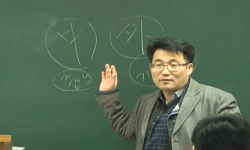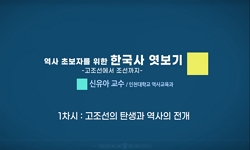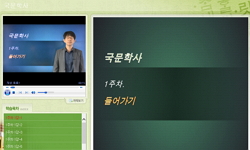본 연구의 목적은 고려시대 충주지역 석불입상의 신앙적 특성과 불상형식의 전통성 여부, 조성 배경 등을 규명해보려는 데 있다. 연구 방법은 문헌조사와 현지조사를 병행하였다. 문헌조사...
http://chineseinput.net/에서 pinyin(병음)방식으로 중국어를 변환할 수 있습니다.
변환된 중국어를 복사하여 사용하시면 됩니다.
- 中文 을 입력하시려면 zhongwen을 입력하시고 space를누르시면됩니다.
- 北京 을 입력하시려면 beijing을 입력하시고 space를 누르시면 됩니다.
https://www.riss.kr/link?id=T8580512
- 저자
-
발행사항
서울 : 弘益大學校 大學院, 2003
- 학위논문사항
-
발행연도
2003
-
작성언어
한국어
- 주제어
-
KDC
911.04 판사항(4)
-
DDC
730.95104951.72704.948943 판사항(20)
-
발행국(도시)
서울
-
형태사항
iv, 87p. : 삽도,도표,도판 ; 26 cm .
-
일반주기명
참고문헌(62-66장) 수록
- 소장기관
-
0
상세조회 -
0
다운로드
부가정보
국문 초록 (Abstract)
본 연구의 목적은 고려시대 충주지역 석불입상의 신앙적 특성과 불상형식의 전통성 여부, 조성 배경 등을 규명해보려는 데 있다.
연구 방법은 문헌조사와 현지조사를 병행하였다. 문헌조사를 통해서는 충주지역의 역사성과 지역적 특성, 그리고 불교미술의 발달 상황을 고찰하였다. 그리고 현지조사를 통해서 충주지역의 지역적 특성을 직접 확인하고 고려시대에 조성된 석불입상의 분포상황과 조성배경에 대한 고찰을 시도하였다.
충주지역은 수륙교통의 요지이면서 군사적 요충지였으므로 삼국시대이래로 각국이 다투어 지배하려는 지역이었다. 따라서 선진문화의 유입도 빨랐으며 아울러 불교미술도 일찍부터 발달하였다.
이 논문의 고찰시기인 고려전기는 국가적 숭불정책으로 인하여 불교가 더욱 대중화되는 시기였다. 그리고 미륵을 주존으로 하는 법상종이 다른 시대에 비해 발달 하였고, 따라서 전국에 걸쳐 미륵불상이 빈번하게 조성되는 시기였다. 또한 풍수지리사상이 유행하여 佛事에도 깊은 영향을 주어 비보사찰과 비보불상이 많이 조성되는 시기였다.
한편 고려전기의 충주지역은 건국초기 유력한 호족이었던 충주 유씨들의 영향력이 컸던 지역이었다. 그리고 국가가 차츰 안정되어 가면서 군사적 요충지로서보다는 수륙교통의 요지로서 역, 원, 창이 설치되어 물산의 집산이 활발하게 이루어지고 그에 따른 타지역인의 왕래가 빈번한 지역이었다. 이러한 시대상황과 지역적 특성 아래 고려시대 충주지역의 13基의 석불입상들이 조성되었다고 볼 수 있다.
논문의 주제 규명을 위한 연구의 결과 고려시대 충주지역의 석불입상의 성격을 다음과 같이 고찰하였다.
첫째, 13基의 석불입상들이 모두 수륙교통로 주변에 조성되어 있었다. 교통의 중심지였던 충주의 지역적 특수성으로 인하여 빈번하게 통과하는 여행자들에게 여행 중의 안녕과 무사귀환을 비는 수호신의 대상으로 석불입상이 조성된 것으로 보인다. 그리고 계립령에서 수안보, 단월, 충주를 경유하여 용원, 숭선으로 연결되는 길이 당시의 주된 육상 교통로였음을 불상 조성위치를 통하여 알 수 있었다.
둘째, 충주지역 석불입상은 규모가 2m 이상으로 큰 불상이 다수 조상되어 있는 점, 주로 수륙교통로 주변에 조성되어 있는 점, 충주가 경제활동이 왕성한 지역이었던 점 등에서 다른 지역 미륵불상보다 특별하다. 이러한 특성은 충주지역 석불상의 미륵신앙적 성격을 파악하는데 주된 단서가 될 것이다. 일반적인 미륵신앙은 새 세상의 도래를 희망하는 미륵하생적 신앙으로 해석되는 데 비하여 충주지역은 보다 실질적이고 적극적인 목적으로 미륵석불을 조성한 것으로 보인다. 그러므로 이 지역 석불입상의 신앙적 특성은 미륵하생적 신앙 형태에서 민간신앙과 습합되어진 모습, 즉 여행자의 수호신으로서의 기복 신앙적인 성격을 가지는 것으로 볼 수 있을 것이다. 우리나라 미륵신앙이 민간신앙과 습합되는 시기는 일반적으로 고려후기부터 본격화되는데 비하여 충주지역은 한걸음 빠르게 나타난 현상이라고 볼 수 있을 것이다.
셋째, 13基의 석불입상 중 5基가 2m이상의 거불들인 점으로 보아 불상조성에 지방 세력가의 후원이 있었을 것으로 추정된다. 건국초기의 막강한 호족세력이었던 충주유씨의 관여가 컸을 것으로 추정되나 확인된 것은 없다. 다만 원평리 석불이 규모와 형식에서 국초의 기상을 나타내고 있어서 가장 관련이 깊을 것으로 추정하였다. 나머지 4基의 거불 들은 불상형식으로 보아 그로부터 1. 2세기 후에 조성된 것들로 보이므로 당시의 유력한 지방귀족의 후원을 받았을 것으로 짐작된다.
넷째, 충주지역 석불입상의 형식은 고려시대 불상의 두 유형이 모두 존재한다. 통일신라 전통을 계승한 원평리 석불이 있고, 보개를 쓰고 석주형의 몸매를 지닌 고려 특유의 불상들이 함께 존재하는 것이다. 두 유형의 불상들은 조성시기의 차이가 1, 2세기 정도 시간차가 있을 것으로 추정되고 형식상으로 전혀 관계가 없는 유형으로 보이나 분명 11-12세기 무렵에 조성된 충주지역의 석주형 석불들의 모델은 신라전통을 계승한 원평리 석불이었을 것이 확실한 것 같다. 결과적으로 충주지역의 거석불들은 통일신라의 이상적인 형식의 불상으로부터 단계적으로 변형되는 결과를 보여주는 것이다.
다섯째, 충주지역 석불입상들은 불상의 형식으로 고찰하였을 때 고려전기에 조성되었을 것으로 조성시기를 추정 하였다.
이상과 같이 볼 때, 고려시대 충주지역 석불입상들은 충주라는 지역적 특성과 깊은 관련 하에 조성되었고, 다른 지역보다 빠른 시기에 전통신앙과 습합되었음을 파악할 수 있다.
다국어 초록 (Multilingual Abstract)
This study aims at examining religious characteristics, the existence of an unique traditional style, and the context of enacting Koryo era stone standing Buddhas in ChungJu. The study is conducted by researching documents and fieldtrips. Through res...
This study aims at examining religious characteristics, the existence of an unique traditional style, and the context of enacting Koryo era stone standing Buddhas in ChungJu.
The study is conducted by researching documents and fieldtrips. Through researching documents, I examined historical and regional uniqueness and the development status of Buddhism art in ChungJu. Through fieldtrips, I attempted to confirm regional uniqueness and examine the distribution and the context of establishing statues.
Being a center of water and land transportation and a military key point, ChungJu had been the area every kingdom seeked to control since three kingdom period. Therefore, influx of advanced culture was fast, enabling the Buddhism art to develop early.
In early Koryo dynasty, the subject period of this study, Buddhism became more popular due to the national pro-Buddhism policy. And because Dharmakava which has Maitreya Buddha as the main Buddha developed further, Maitreya Buddha was frequently enacted nationwide. Additionally, Fengshui was popular and had influence on Buddhism affairs, therefore a lot of Fengshui temple and Buddha statues were enacted in this period.
On the other hand, ChungJu Yu's had strong control over ChungJu in early Koryo dynasty. As the kingdom gradually became stabilized, stations, centers, storehouses were installed as a military and traffic key point, creating major inflow of goods and visitors. Under these periodical and regional traits, thirteen Koryo dynasty stones standing Buddhas were enacted.
After researching subjects of the thesis, the characteristics of Koryo period stone standing Buddhas in ChungJu were found as follows.
First, the thirteen standing stones of Buddha were all enacted along transportation routes. It appears ChungJu, a traffic center, enacted standing stones of Buddha as guardians of safe journey and return or sometimes as milestones.
Second, stone standing Buddhas in ChungJu are unique in that many of them are taller than two meters, that they were enacted along transportation routes, and that ChungJu was economic center. These characteristics are key to understand Mireuk beliefe characteristics of stone standing Buddhas in ChungJu.. While general Mireuk religion is understood as Messianism which wishes the advent of new world, Mireuk religion in ChungJu appears to have had more practical and proactive goals. Therefore, religious traits of standing stones of Buddha in the area can be understood not as Messianism but as folk religion for travelers.
Third, judging from the fact that five of thirteen standing stones of Buddha are taller than two meters, local wealth's sponsorship is presumed. Involvement of ChungJu Yu's, one of powerful clans in the founding period of the kingdom, is presumed although not confirmed. Anyhow, WonpyoungLi stone standing Buddha is thought to have had the closest tie to the family, because its size and forms represents the spirit of the founding period. For other four giant Buddhas appear to have been enacted one to two centuries later, they are presumed to be enacted under the sponsorship of local noble families at that time.
Fourth, these statues are in both two styles of Buddhist statues of Koryo dynasty. There are both WonPyoungLi stone standing Buddhas which follow the Shilla tradition and Buddhas with a unique style of Koryo dynasty era. Although these two groups of statues are estimated to have been enacted about one century apart from each other and appear to be of different styles, the stone pillar style Buddhas enacted around 11 to 12th centure were modeled after WonPyoungLi stone standing Buddhas that follow Shilla traditions. Therefore, giant Buddhas in ChungJu show steps of evolution from ideal styles of Tongil Shilla Buddhist statues.
Finally, I dated stone standing Buddha in ChungJu to have been enacted in early Koryo dynasty, considering the style of the statues.
As stated above, it can be found that Koryo dynasty era stone standing Buddhas in ChungJu were enacted in close context with regional uniqueness of Chungju and that they were intertwined with traditional religions earlier than those in other areas.
목차 (Table of Contents)
- 목차
- 國文抄錄 = i
- I. 머리말 = 1
- II. 歷史的 및 美術史的 背景 = 4
- 1. 역사적으로 본 충주지역의 특성 = 4
- 목차
- 國文抄錄 = i
- I. 머리말 = 1
- II. 歷史的 및 美術史的 背景 = 4
- 1. 역사적으로 본 충주지역의 특성 = 4
- 2. 충주지역의 불교미술 = 10
- 3. 고려시대 석조불상의 현황 = 12
- III. 高麗時代 忠州地域 石佛立像의 現況 = 17
- IV. 高麗時代 忠州地域 石佛立像의 性格 = 41
- 1. 수륙교통로와의 연관성 = 41
- 2. 미륵신앙적 성격 = 46
- 3. 지방세력과의 관계 = 53
- 4. 석불입상 형식의 특성 = 55
- 5. 조성시기의 추정 = 58
- V. 맺음말 = 59
- 參考文獻 = 62
- 圖版目錄 = 67
- 英文抄錄 = 84












